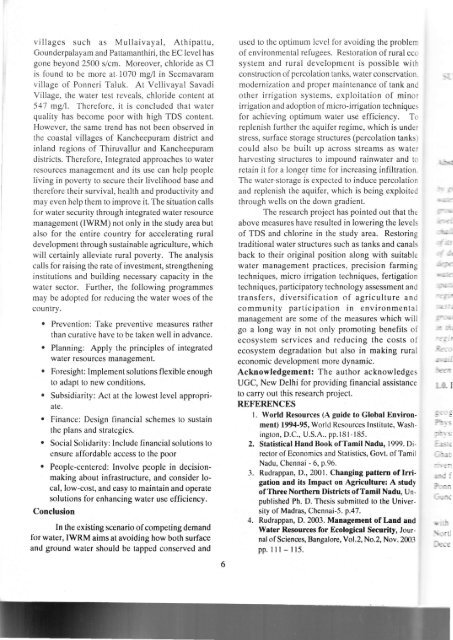Download (4Mb) - Covenant University Repository
Download (4Mb) - Covenant University Repository
Download (4Mb) - Covenant University Repository
You also want an ePaper? Increase the reach of your titles
YUMPU automatically turns print PDFs into web optimized ePapers that Google loves.
villages such as Muilaivayal, Athipattu,<br />
Gounderpalayam and Pattamanthiri, the EC level has<br />
gone beyond 2500 s/cm. Moreover, chloride as Cl<br />
is found to be more at- 1070 mg/l in Seemavaram<br />
village of Ponneri Taluk. At Vellivayal Savadi<br />
Village, the water test reveals, chloride content at<br />
547 mg4. Therefore. it is concluded that water<br />
quality has become poor with high TDS content.<br />
However, the same trend has not been observed in<br />
the coastal villages of Kancheepuram district and<br />
inland regions of Thiruvallur and Kancheepuram<br />
districts. Therefore, Integrated approaches to water<br />
resources management and its use can help people<br />
living in poverty to secure their livelihood base and<br />
therefore their survival, health and productivity and<br />
may even help them to improve it. The situation calls<br />
for water security through integrated water resource<br />
management (IWRM) not only in the study area but<br />
also for the entire country for accelerating rural<br />
development through sustainable agriculture, which<br />
will certainly alleviate rural poverty. The analysis<br />
calls lbr raising the rate of investment, strengthening<br />
institutions and building necessary capacity in the<br />
water sector. Further, the following programmes<br />
may be adopted for reducing the water woes of the<br />
country.<br />
r Prevention: Take preventive measures rather<br />
than curative have to be taken well in advance.<br />
r Planning: Apply the principles of integrated<br />
water resources management.<br />
. Foresight: Implement solutions flexible enough<br />
to adapt to new conditions.<br />
. Subsidiarity: Act at the lowest level appropri-<br />
ate.<br />
o Finance: Design linancial schemes to sustain<br />
the plans and strategies.<br />
r Social Solidarity: Include financial solutions to<br />
ensure aflbrdable access to the poor<br />
r People-centered: Involve people in decisionmaking<br />
about infrastructure, and consider local,<br />
low-cost, and easy to maintain and operate<br />
solutions lbr enhancing water use efficiency.<br />
Conclusion<br />
In the existing scenario of competing demand<br />
lbr water, IWRM aims at avoiding how both surface<br />
and ground water should be tapped conserved and<br />
used to the optimum level for avoiding the problern<br />
of environmental refugees. Restoration of rural ecc<br />
system and rural developrnent is possible with<br />
constructionofpercolationlanks,waterconservation. .i_<br />
modernization and proper maintenance of tank anci<br />
other irrigation systems, exploitation of minor<br />
irrigation and adoption of micro-inigation techniques<br />
for achieving optimum water use efficiency. Tc<br />
replenish further the aquifer regime, which is under<br />
stress, surface storage structures (percolation tanks)<br />
could also be built up across streams as water<br />
harvesting structures to impound rainwater and to r,:br<br />
retain it tbr a longer time lbr increasing infiltration.<br />
The water.storage is expected to induce percolation<br />
and replenish the aquifer, which is being exploited j'<br />
through wells on the down gradient.<br />
The research project has pointed out that the<br />
above measures have resulted in lowering the levels<br />
of TDS and chlorine in the study area. Restoring<br />
traditional water structures such as tanks and canals<br />
back to their original position along with suitable<br />
' 5 :<br />
r* r-<br />
water management practices, precision farming :e:r:<br />
techniques, micro irrigation techniques, fertigation t,;jr.<br />
techniques, participatory technology assessment and :.;::'<br />
transfers, diversification of agriculture and<br />
community participation in environmental<br />
-: j.. '<br />
r--lmanagement<br />
are some of the measures which will ;-* - 'ai<br />
go a long way in not only promoting benefits of<br />
ecosystem services and reducing the costs of<br />
rT ;1;<br />
-: i-,<br />
ecosystem degradation but also in making rural i.1'-'-,<br />
economic development more dynamic.<br />
i'. i-:<br />
Acknowledgement: The author acknowledges ldg"I<br />
UGC, New Delhi for providing financial assistance<br />
to carry out this research project.<br />
REFERENCES<br />
l"i}. I<br />
1. World Resources (A guide to Global llnvironment)<br />
1994-95, World Resources lnstitute, Wash-<br />
i*-. l<br />
ington, D.C., U.S.A.. pp.l8l-185.<br />
2. Statistical Hand Book of Tamil Nadu, 1999. Di-<br />
lrni S:<br />
l:
















